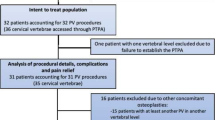Abstract
Percutaneous access to the upper thoracic vertebrae under fluoroscopic guidance is challenging. We describe our positioning technique facilitating optimal visualisation of the high thoracic vertebrae in the prone position. This allows safe practice of kyphoplasty, vertebroplasty and biopsy throughout the upper thoracic spine.
Similar content being viewed by others
Explore related subjects
Discover the latest articles, news and stories from top researchers in related subjects.Avoid common mistakes on your manuscript.
Introduction
Boszczyk et al. [2] have advocated fluoroscopically guided kyphoplasty cranial to T5. They have shown the trans-costovertebral approach to the high thoracic spine can be successfully used for kyphoplasty, vertebroplasty and biopsy.
Optimal visualisation is paramount for safe placement of instruments due to the close proximity of the spinal canal, the pleural cavity and major vascular structures. With conventional prone positioning, the scapula and humeral head are superimposed on the spine in the lateral image.
We describe a simple patient positioning modification that significantly improves the lateral visualisation of the upper thoracic spine during percutaneous procedures.
Technique
The patient is positioned prone on conventional bolsters. The arms remain adducted. A midline longitudinal bolster is placed under the sternum allowing the scapulae to fall anteriorly avoiding overlay of the shoulder girdle on the lateral fluoroscopic image (Figs. 1, 2, 3).
For those procedures performed under sedation rather than general anaesthetic, a midline longitudinal sternal bolster is still positioned, but the arms can be placed with the shoulders abducted and elbows flexed as shown. This is more comfortable for the patient and still allows good visualisation up to T2 (Fig. 4).
In our experience, this has allowed clear fluoroscopic visualisation of the upper thoracic spine (Fig. 5).
Discussion
Ottolenghi [8] was the first to advocate thoracic vertebral biopsy above T9 and described the intercostal approach. More recently, trans-pedicular and trans-costovertebral approaches have been described [1, 3–6, 9]. CT guidance has been described as safer than fluoroscopic guidance [10]; however, a recent meta-analysis has suggested no significant difference in complication rates (3.3–5.3%) [7].
We favour the trans-costovertebral approach using fluoroscopic guidance, as described by Boszczyk et al. [2]. This allows safe use of large cannulas or biopsy needles with a potentially larger diameter than the upper thoracic pedicles, thus avoiding spinal canal intrusion.
The described modified position allows clear fluoroscopic lateral imaging of the upper thoracic spine. The image is not obscured by the shoulder girdle. This facilitates safe cannula or needle placement in the upper thoracic spine. We have accessed 23 vertebrae between T1 and T5 successfully with this technique.
References
Babu NV, Titus VT, Chittaranjan S, Abraham G, Prem H, Korula RJ (1994) Computed tomographically guided biopsy of the spine. Spine 19(21):2436–2442. doi:10.1097/00007632-199411000-00013
Boszczyk BM, Bierschneider M, Hauck S, Beisse R, Potulski M, Jaksche H (2005) Transcostovertebral kyphoplasty of the mid and high thoracic spine. Eur Spine J 14(10):992–999. doi:10.1007/s00586-005-0943-1
Brugieres P, Gaston A, Heran F, Voisin MC, Marsault C (1990) Percutaneous biopsies of the thoracic spine under CT guidance: transcostovertebral approach. J Comput Assist Tomogr 14(3):446–448. doi:10.1097/00004728-199005000-00023
Donaldson WF 3rd, Johnson DW (1996) Percutaneous biopsy of the thoracic spine. Neurosurg Clin N Am 7(1):135–144
Ghelman B, Lospinuso MF, Levine DB, O’Leary PF, Burke SW (1991) Percutaneous computed-tomography-guided biopsy of the thoracic and lumbar spine. Spine 16(7):736–739. doi:10.1097/00007632-199107000-00008
Mick CA, Zinreich J (1985) Percutaneous trephine bone biopsy of the thoracic spine. Spine 10(8):737–740. doi:10.1097/00007632-198510000-00008
Nourbakhsh A, Grady JJ, Garges KJ (2008) Percutaneous spine biopsy: a meta-analysis. J Bone Jt Surg Am 90(8):1722–1725. doi:10.2106/JBJS.G.00646
Ottolenghi CE (1969) Aspiration biopsy of the spine. Technique for the thoracic spine and results of twenty-eight biopsies in this region and overall results of 1050 biopsies of other spinal segments. J Bone Jt Surg Am 51(8):1531–1544
Pierot L, Boulin A (1999) Percutaneous biopsy of the thoracic and lumbar spine: transpedicular approach under fluoroscopic guidance. AJNR Am J Neuroradiol 20(1):23–25
Rimondi E, Staals EL, Errani C, Bianchi G, Casadei R, Alberghini M, Malaguti MC, Rossi G, Durante S, Mercuri M (2008) Percutaneous CT-guided biopsy of the spine: results of 430 biopsies. Eur Spine J 17(7):975–981. doi:10.1007/s00586-008-0678-x
Acknowledgments
Illustrations are courtesy of spinegraphics@gmx.net.
Author information
Authors and Affiliations
Corresponding author
Rights and permissions
About this article
Cite this article
Bayley, E., Clamp, J. & Boszczyk, B.M. Percutaneous approach to the upper thoracic spine: optimal patient positioning. Eur Spine J 18, 1986–1988 (2009). https://doi.org/10.1007/s00586-009-1075-9
Received:
Accepted:
Published:
Issue Date:
DOI: https://doi.org/10.1007/s00586-009-1075-9









